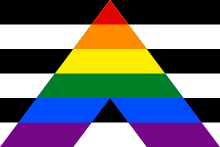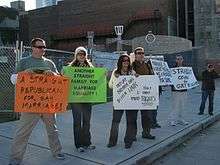Straight ally
An ally, straight ally, heterosexual ally or cisgender ally is a heterosexual and cisgender person who supports equal civil rights, gender equality, and LGBT social movements, challenging homophobia, biphobia, and transphobia. Not everyone who meets this definition identifies as an "ally". An ally acknowledges that LGBTQ people face discrimination and thus are socially disadvantaged. They aim to use their position and privilege as heterosexual and cisgender individuals in a society focused on cisnormativity and heteronormativity to counter discrimination against LGBTQ people. Several LGBTQ organizations (both on local and state levels) center the development of allies in working towards their social justice goals.

There are various stages to being an ally, each one contributing to the queer social movement in a different way and each also subject to distinct criticism regarding motive. Regardless, all stages contribute support for policy initiatives that aim to benefit the LGBTQ community as a whole.
LGBTQ ally organizations

Most LGBT organizations have straight or cisgender members involved; others actively encourage straight and cisgender participation. A gay–straight alliance (also known as a gender-sexuality alliance) is a student-run club that brings together LGBT and straight students to create a platform for activism to fight homophobia and transphobia.[1] There are also some groups that unite the LGBT community to work together with allies. Founded in 1973, PFLAG is the original ally organization, started by Jeanne Manford, mother of the Ally movement. Based in the United States, PFLAG unites LGBTQ+ people with parents, families, and allies to gain full civil and legal equality for LGBTQ+ people. In 2007, the organization launched a new project, Straight for Equality[2] to help more allies become engaged in the LGBTQ+ movement in the workplace, healthcare, and now in faith communities. Gay & Lesbian Advocates & Defenders (GLAD) is another organization specifically formed to group allies of this cause.
Historical background
The Stonewall Riots of 1969 (in New York City) are known to be the starting point of the Gay Liberation Front. Protests, advocacy organizations, HIV/AIDS relief groups, etc., collectively have characterized the movement from the start. In the 1970s, a divide emerged within the community over opposing beliefs on what liberation truly meant.
The two groups that formed as a result of the split were known most generally as the ‘liberationists’ and the ‘homophiles’ [3]. Liberationists presented themselves as being considerably radical; their intent lay in going beyond acceptance and transforming traditional constructs of society (homophobia, sexism, militarism, etc.). In contrast, homophiles aimed only for what was deemed realistic; instead of dismantling an oppressive system, they simply asked for tolerance [3]. Their group maintained an apologist standpoint, where their end goal was living in peaceful coexistence with the oppressor[3]. This assimilationist perspective tended to attract more cis, white queers in the movement who had the luxury of being able to blend in, as opposed to the liberationists, who seemed to be drawing in those more marginalized (queer/trans people of color).
In the context of queer advocacy and activism, using allies is often perceived as homophilic. It has sparked widespread debate, for working so closely with the ‘oppressor’ resembles the same type of conservative approaches that many in the movement reject.
Stages of allyship
Sociologist Keith Edwards identifies three stages to the process of becoming an ally in a social movement[4].
The first stage of allyship is rooted in self-interest. These allies goals focus entirely on those they love. When taking action as an ally, their impact is individualistic - they perceive the issues of their loved one to have stemmed from the influence of a certain group of people rather than believing the issues to be symptomatic of a greater, oppressive system. This exhibition of early allyship is not necessarily harmful, but since it does not address the larger problem its effectiveness is limited. Self-interested behavior is most often associated with parents supporting their children, and although these parents are key supporters in the community, what is not always clear is whether their help would extend beyond their own family and friends[4]. An example of this behavior is a dad of a transgender daughter advocating for gender neutral bathrooms at his daughter's school - however his advocacy is a result of loving his daughter, not a desire to help transgender folx at large.
The second stage in Edward’s model is that of the ally aspiring for altruism. This is a more developed stage than the former because the ally’s motivations are directed towards combating the oppression of an entire group instead of just one individual. They are also more established in the sense that allies at this level begin to show awareness of their societal privilege, yet they have a tendency to assume a savior role toward those they aim to help [4]. This savior mentality avoids the core problem: it fails to acknowledge the systemic nature of the oppression of queer/LGBTQ/trans folx.
The third stage of allyship is the ally who fights for social justice. The main driver of this stage above all else is respect for those who are oppressed[4]. In contrast to the prior two approaches, allies in the third stage are aware that the group they support is fully capable of advocating for themselves. This kind of ally is not condescending[4]. They battle the oppressive system so that the entire community benefits from the corrections, not plainly a select few.
Challenges raised by straight allies
The main challenge of partnering with straight allies is that they evince different levels of 'respect' for the community on whose behalf they advocate, sometimes being patronizing, unaware of their own privilege and power, and crowding out the members [4]. Given that distinguishing the line between speaking on behalf of a group and speaking for a group is not simple, much of the time that line is crossed without even noticing. This grey area can be referred to as ‘negative respect’; a sort of force found in an ally's motives that inhibits the ‘servile’ (as a result of their internalized oppression) group's freedom to act [4].
Another challenge is that straight allies can be easily discouraged, in the face of close scrutiny of their motives and approaches. Newer straight allies can become overwhelmed by the complication of their position in the movement. Since newer allies derive their identity from their personal relations with queer-identifying people, this limits their allyship [5]. Allies tend to respond very defensively to criticism from members of the queer community about their understanding of queer issues, which in turn feeds a concern that they are motivated by the praise they anticipate as their moral reward. Additionally there is a coming out process for being a straight ally that is not explicitly present in other social movements (concerns about being seen as LGBTQ+); this can hinder the level of advocacy an ally does [5]. In other words, allyship requires a support that is accompanied with a distinct protocol many find challenging to achieve.

Some children of LGBT couples are straight allies, notably Iowan Zach Wahls, the son of two lesbians, though he has expressed a different view of his relationship to the LGBT community:[6]
To be clear, I don't consider myself an ally. I might be [a] straight cisgender man, but in my mind, I am a member of the LGBT community. I know the last thing that anyone wants is to add another letter to the acronym, but we need to make sure as a movement we're making a place for what we call "queer-spawn" to function and to be part of the community. Because even though I'm not gay, I do know what its like to be hated for who I am. And I do know what its like to be in the closet, and like every other member of the LGBT community, I did not have a choice in this. I was born into this movement.
Allies may receive criticism for a variety of reasons. For example, some believe that allies are unable to step outside their own heteronormative world to advocate.[7] Allies are also criticized for using LGBTQ advocacy as a means to gain popularity and status.[8]
Role of straight allies in policy change
Studies show that elite allies have a positive effect on the policy goals of a social movement, whatever those goals may be [9]. While allies' main role is to provide wider support for the goals of a social movement, their secondary role of influencing policy is also valuable[9]. The allies' role is to inform policy makers of the struggles endured by a community. Allyship of this kind is often effective, though self-interested; for example, high-ranking, conservative government officials Barry Goldwater and William Weld (former Republican governor of Massachusetts), were motivated by their relations with queer family and friends to provide uncharacteristic support for pro-gay policies [10].
Straight allies play a key role in re-politicizing issues and improving state provisioning for that issue. A perfect example of such a circumstance is in the HIV/AIDS crisis of the 1980s, when straight allies were pivotal in countering the bigotry that characterized its early politics. Currently, queer activists together with their allies are once again making the government’s policies on AIDS a point of correction in order to make the medication more financially accessible.
See also
- Athlete Ally
- Atticus Circle
- Gay & Lesbian Alliance Against Defamation (GLAAD)
- Homophile
- Human Rights Campaign – LGBT rights
- Human rights in the United States
- LGBT rights in the United States
- Straight Alliance for LGBT Equality in Russia (in Russian)
References
- "What We Do: Gay-Straight Alliance". Gsanetwork.org. Retrieved 2011-07-21.
- "Straight for Equality website". Straightforequality.org. Retrieved 2013-08-17.
- LGBTQA, Benjamin H. ShepardTopics: (2001-05-01). "Monthly Review | The Queer/Gay Assimilationist Split". Monthly Review. Retrieved 2020-05-12.CS1 maint: extra punctuation (link)
- "Towards a Moral Conception of Allyship".
- Grzanka, P. R., Adler, J., & Blazer, J. (2015). Making up allies: The identity choreography of straight LGBT activism. Sexuality Research & Social Policy, 12(3), 165-181. doi:http://dx.doi.org/10.1007/s13178-014-0179-0
- Washington Blade: Phil Reese, "'That kid from YouTube'," May 23, 2012, accessed June 2, 2012
- DeTurk, Sara (2011). "Allies in Action: The Communicative Experiences of People Who Challenge Social Injustice on Behalf of Others". Communication Quarterly. 59 (5): 569–590. doi:10.1080/01463373.2011.614209.
- Becker, Ron (2006). "Gay-Themed Television and the Slumpy Class: The Affordable, Multicultural Politics of the Gay Nineties". Television & New Media. 7: 184–215. doi:10.1177/1527476403255830.
- "Friends or foes? How social movement allies affect the passage of legislation in the US Congress" (PDF).
- Reger, Jo, Daniel J. Myers, and Rachel L. Einwohner, eds. Identity work in social movements. Vol. 30. U of Minnesota Press, 2008.
External links
- Straight for Equality—a straight ally organization
- Human Rights Campaign (a gay rights organization) on being a straight ally
- Atticus Circle—a straight ally organization
- Allies Out For Change—a straight ally organization